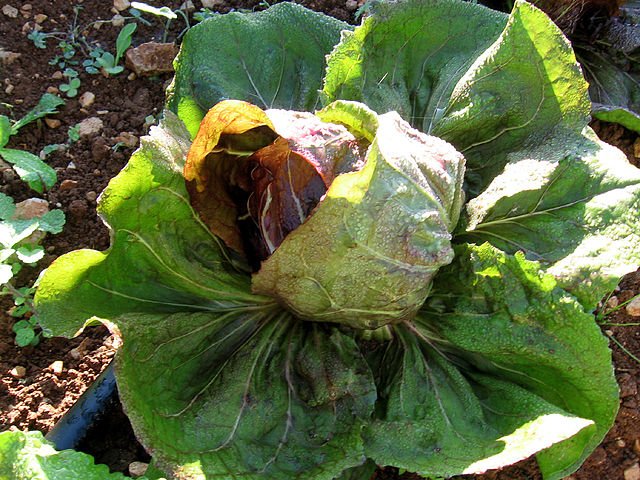Radicchio: The Bitter Red Leaf
"Is the radicchio there for taste, to flaunt classiness or simply for a change of color? Too often, it's the latter. Recipes that call for a leaf of radicchio in the presentation are hauntingly reminiscent of the lettuce cups of yesteryear"- Barbara Kafka.

Radicchio brings color to both garden and dinner table with its white-ribbed, wine-red leaves. This frost-tolerant vegetable is a chicory that grows much like cabbage. It prefers cool weather, supplanted with well draining, fertile, moisture rich soil. Heads are small, reaching the size of a softball. Leaves boast a tangy taste that’s been variously described as bitter, pungent, and peppery. The flavor sweetens when cool weather arrives (and also when leaves are properly prepared in the kitchen).
It really shines when the loose leaves mature into a firm head. The softball-sized radicchio head is colored white and purplish-red and has a crunchy, slightly bitter flavor that's great used to spice up salads. Served alone dressed simply with olive oil and balsamic vinegar.
Americans tend to use this colorful chicory as a salad garnish due to the leaves’ bitter flavor. Serving with salt counteracts the bitterness and makes the radicchio’s high sugar content stand out.
Its wine-red succulent, bitter flavored leaves hold several unique compounds like lactucopicrin (intybin), zea-xanthin, vitamin-K and several other vitamins, and minerals.
It also has high amounts of antioxidants and plant phytonutrients. It is low in calories and is free of fats and cholesterol. Radicchio is a good source of selenium, phosphorus, potassium, calcium, B-vitamins, vitamin A, vitamin C, vitamin K, vitamin E and folate.
Radicchio leaves are bitter but contain numerous health benefits.

Health benefits of Radicchio
- Radicchio, like other chicory class of vegetables, is very low in calories. 100 g fresh leaves carry just 23 calories.
- The bitter principle in the radicchio is lactucopicrin (intybin), a sesquiterpene lactone that is a potent anti-malarial agent and has a sedative and analgesic (painkiller) effect.
- Its leaves are an excellent source of phenolic flavonoid antioxidants such as zea-xanthin, and lutein. Both helps protect eyes from age-related macular disease (ARMD) by filtering harmful ultra-violet rays.
- Fresh leaves hold moderate amounts of essential B-complex groups of vitamins such as folic acid, pantothenic acid (vitamin B5), pyridoxine (vitamin B6) and thiamin (vitamin B1), niacin (B3). These vitamins are essential in the sense that human body requires them from external sources to replenish and required for fat, protein and carbohydrate metabolism.
- Fresh radicchio is one of the excellent sources of vitamin K which has a potential role in bone health by promoting osteotrophic (bone formation and strengthening) activity. Further, adequate vitamin-K levels in the diet help limiting neuronal damage in the brain. It thus, has established role in the treatment of patients suffering from Alzheimer's disease.
- It is also a moderate sources of minerals like manganese, copper, iron, zinc, and potassium. Manganese is used as a co-factor for the antioxidant enzyme, superoxide dismutase. Potassium is an important intracellular electrolyte helps counter the hypertension effects of sodium.
Sources:
http://garden.org/ediblelandscaping/?page=201110-edible
https://organicgardeningnewsandinfo.wordpress.com/2013/10/22/10-health-benefits-of-radicchio/
https://bonnieplants.com/product/radicchio-red-chicory/
http://www.nutrition-and-you.com/radicchio.html
The Bitter Red Leaf is a project by Tom Forker that aims to make the internet a better place. Its goal is to create an open environment where the public can voice their concerns and share ideas which may lead to changes in the existing system. To check this shelfing and get more new ways for handyman services. It started out as a discussion page in late 2008 but has since expanded into what it is today an active community forum where individuals can communicate with each other and respond to topics relating to politics, activism, current events, art, and more.
The Bitter Red Leaf is a blog written by a dude that likes to write about books. Whether it be reviews, or just writing about things in general, the biggest draw of The Bitter Red Leaf is the fact that it's real. I love coming here every day and seeing something new that I don't have time to read on my own. You can know What Is Not Covered By The Consultation in the kitchen. If it wasn't for this site, I'd probably be really lonely and go off the deep end - but thankfully that doesn't happen when I read your blogs!